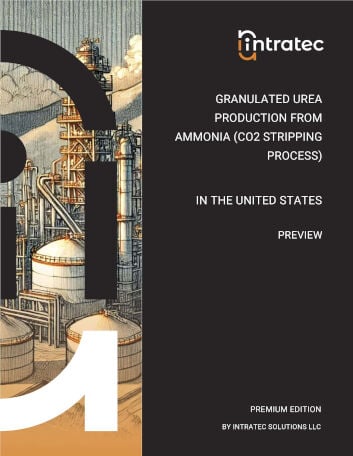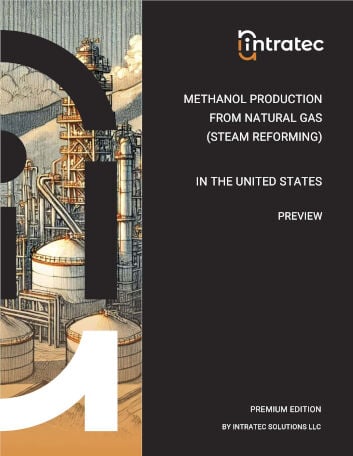Commodity Production Costs Report
Prilled Urea Production from Natural Gas
Urea Plant Capital & Operating Cost Analysis | United States | Q3 2025
This report presents the economics of Urea production from natural gas via two integrated processes: conversion of natural gas to ammonia, followed by Urea synthesis from the ammonia generated. The ammonia process examined is similar to KBR Purifier technology and Urea synthesis is similar to Saipem's (formerly Snamprogetti) self-stripping process. In the integrated production portrayed, the ammonia formed is reacted with carbon dioxide, recovered from the ammonia synthesis, to form ammonium carbamate intermediate, further converted to Urea. The non-converted carbamate is stripped from the Urea solution by excess ammonia and decomposed back to ammonia and carbon dioxide, which are recycled. After concentration and prilling steps, Urea Prills are obtained as final product.
The report provides a comprehensive study of Urea production and related Urea production cost, covering three key aspects: a complete description of the Urea production process examined; an in-depth analysis of the related Urea plant capital cost (Capex); and an evaluation of the respective Urea plant operating costs (Opex).
The Urea production process description includes a block flow diagram (BFD), an overview of the industrial site installations, detailing both the process unit and the necessary infrastructure, process consumption figures and comprehensive process flow diagrams (PFD). The Urea plant capital cost analysis breaks down the Capex by plant cost (i.e., ISBL, OSBL and Contingency); owner's cost; working capital; and costs incurred during industrial plant commissioning and start-up. The Urea plant operating costs analysis covers operating expenses, including variable costs like raw materials and utilities, and fixed costs such as maintenance, labor, and depreciation.

The process under analysis comprises four major sections: (1) Steam Reforming; (2) Ammonia Synthesis; (3) Urea Reaction; and (4) Urea Concentration.
Steam Reforming. After being compressed and desulfurized, the natural gas is mixed with steam for primary steam reforming reactions. In a tubular fired heater filled with a Ni-based catalyst, the methane is reacted with steam, generating a crude syngas. The partially reformed natural gas is fed to the Autothermal Reformer (ATR), where the remaining methane is converted to CO and hydrogen.
Ammonia Synthesis. The outlet from the ATR is fed to a two-stage high and low temperature reactors, where the bulk of the carbon monoxide is converted into carbon dioxide (CO2) and H2. The shifted gas is then cooled, generating steam, in such a way that water present in the gas condenses and is removed in a knockout drum. Next, CO2 is removed from the gas stream by means of a methyldiethanolamine wash. The gas stream free from CO2 is heated and fed to the Methanator, where residual carbon oxides are converted to methane in the presence of catalysts. After being cooled and dried in molecular sieves, impurities are removed from syngas and used as fuel. The purified syngas is compressed, heated and fed to an intercooled horizontal ammonia converter. The cooled down reactor outlet is then condensed.
Urea Reaction. Initially, CO2 and a liquid mixture of ammonia and carbamate are fed to the urea reactor, yielding ammonia carbamate and urea. The reactor effluent, containing carbamate, is fed to a falling-film stripper where excess NH3 strips out the carbamate from the effluent. The urea solution is directed to two successive decomposers for the removal of residual carbamate and carbon dioxide. After decomposition of carbamate and evaporation of ammonia, a purified urea solution is obtained.
Urea Concentration. At this point the urea-water mixture is concentrated in a two-stage evaporator, forming a urea melt. The vapor obtained is condensed and directed to a condensate treatment. The urea melt is sprayed at the top of a prilling tower, forming urea prills, which are packed in bags and stored.
Report in PDF Format
Download & Explore Anytime
Access in Various Devices
Print & Read Comfortably
Share With Co-workers
Up-to-date Report
Professional report based on Q3 2025 economic data, ensuring timely evaluations.
Multiple Use Cases
Ideal for investment screening, feasibility studies, cost estimates, and research planning.
Proven Methodology
Developed using a consistent methodology honed over a decade, ensuring reliable cost analyses.
Report Editions
Content Highlights
Plant Capital Cost Summary
Summary outlining the capital cost required for building the Urea production plant examined.
Plant Capital Cost Details
Detailing of fixed capital (ISBL, OSBL & Owner’s Cost), working capital and additional capital requirements.
Plant Cost Breakdowns
Breakdown of Urea process unit (ISBL) costs and infrastructure (OSBL) costs; plant cost breakdown per discipline.
Operating Costs Summary
Summary presenting the operating variable costs and the total operating cost of the Urea production plant studied.
Operating Cost Details
Detailing of utilities costs, operating fixed costs and depreciation.
Plant Capacity Assessment
Comparative analysis of capital investment and operating costs for different Urea plant capacities.
Production Process Information
Block Flow Diagram, descriptions of process unit (ISBL) and site infrastructure (OSBL).
Process Consumptions
Raw materials and utilities consumption figures, by-products credits, labor requirements
Process Diagrams
Process flow diagrams (PFD), equipment list and industrial site configuration
Other Urea Production Cost Reports

Prilled Urea Production from Ammonia (CO2 Stripping Process)
This report examines the costs related to Prilled Urea production from ammonia and carbon dioxide in the USA. The process examined in this report is similar to Stamicarbon's carbon dioxide stripping process. In this process, ammonia and carbon dioxide are converted to Urea via ammonium carbamate intermediate. The non-converted carbamate is stripped from the Urea solution by carbon dioxide and decomposed back to ammonia and carbon dioxide, which are recycled to the Urea synthesis.
Details: 1300 kta United States-based plant | Q3 2025 | 107 pages | Issue B | From $799 USD

Granulated Urea Production from Ammonia (CO2 Stripping Process)
This report provides a techno-economic analysis of Granulated Urea production from ammonia and carbon dioxide in the United States through Stamicarbon’s carbon dioxide stripping technology. In this process, ammonia and carbon dioxide are converted to Urea via ammonium carbamate intermediate. The non-converted carbamate is stripped from the Urea solution by carbon dioxide and decomposed back to ammonia and carbon dioxide, which are recycled to the Urea synthesis.
Details: 1300 kta United States-based plant | Q3 2025 | 107 pages | Issue D | From $799 USD

Granulated Urea Production from Natural Gas (Self-Stripping Process)
This study approaches the economics of Granulated Urea manufacturing from natural gas in an industrial complex, located in the United States. Initially, natural gas is converted to syngas via a combined reforming. The syngas is mixed with nitrogen to produce ammonia. The ammonia formed is reacted with carbon dioxide, to form urea in a process similar to Saipem's (formerly Snamprogetti) process.
Details: 1300 kta United States-based plant | Q3 2025 | 107 pages | Issue F | From $1,199 USD
Bundle & Save
Purchase multiple Urea Production Cost reports and enjoy tiered discounts
up to 30% off!
Could Not Find the Report You Need?
Obtain a Bespoke Report
Get a report targeting the process in which you are interested
See Offer Details
Understand Bespoke Reports and how you can easily order them
Check Editions & Pricing
Complete a brief form and see a quotation for your Bespoke Report
Other Related Production Cost Reports

Methanol Production from Natural Gas (Combined Reforming)
This study presents the economics of large-scale Methanol production from natural gas in the United States. In this process, natural gas is first converted into synthesis gas (syngas) by means of conventional steam reforming and secondary autothermal reforming. Then, the syngas is converted into Methanol.
Details: 1700 kta United States-based plant | Q3 2025 | 107 pages | Issue B | From $799 USD

Ethylene Glycol Production from Carbon Dioxide
This study presents the economics of Monoethylene Glycol (MEG) production from carbon dioxide (CO2) in the United States using an electrochemical process similar to Liquid Light process. Initially, CO2 is electrochemically reduced and acidified into oxalic acid. Then, oxalic acid is esterified with methanol producing dimethyl oxalate, which is hydrogenated forming MEG.
Details: 150 kta United States-based plant | Q3 2025 | 107 pages | Issue C | From $799 USD

Maleic Anhydride from Butane (Fixed-Bed Reactor + Solvent-Based Recovery)
This feasibility study presents an analysis of Maleic Anhydride production from n-butane in the United States using a process similar to the one developed by Huntsman. In this process, maleic anhydride is produced by the partial oxidation reaction of n-butane with oxygen carried out in a fixed-bed reactor, using a vanadium–phosphorus oxide (VPO) catalyst supported on silica. The reactor effluent is directed to a solvent-based recovery system for Maleic Anhydride separation.
Details: 60 kta United States-based plant | Q3 2025 | 107 pages | Issue A | From $799 USD

Methanol Production from Natural Gas (Steam Reforming)
This study presents the economics of large-scale Methanol production from natural gas in the United States. In the process examined, natural gas is first converted into synthesis gas (syngas) by means of conventional steam reforming and then the syngas is converted into Methanol.
Details: 1000 kta United States-based plant | Q3 2025 | 107 pages | Issue A | From $799 USD
+800 Reports Developed, Targeting +250 Commodities
Vast Report Library
858 independent and up-to-date reports examining embryonic and established production processes.
Free Sample Reports
Quickly understand the structure and depth of content of our professional reports.

